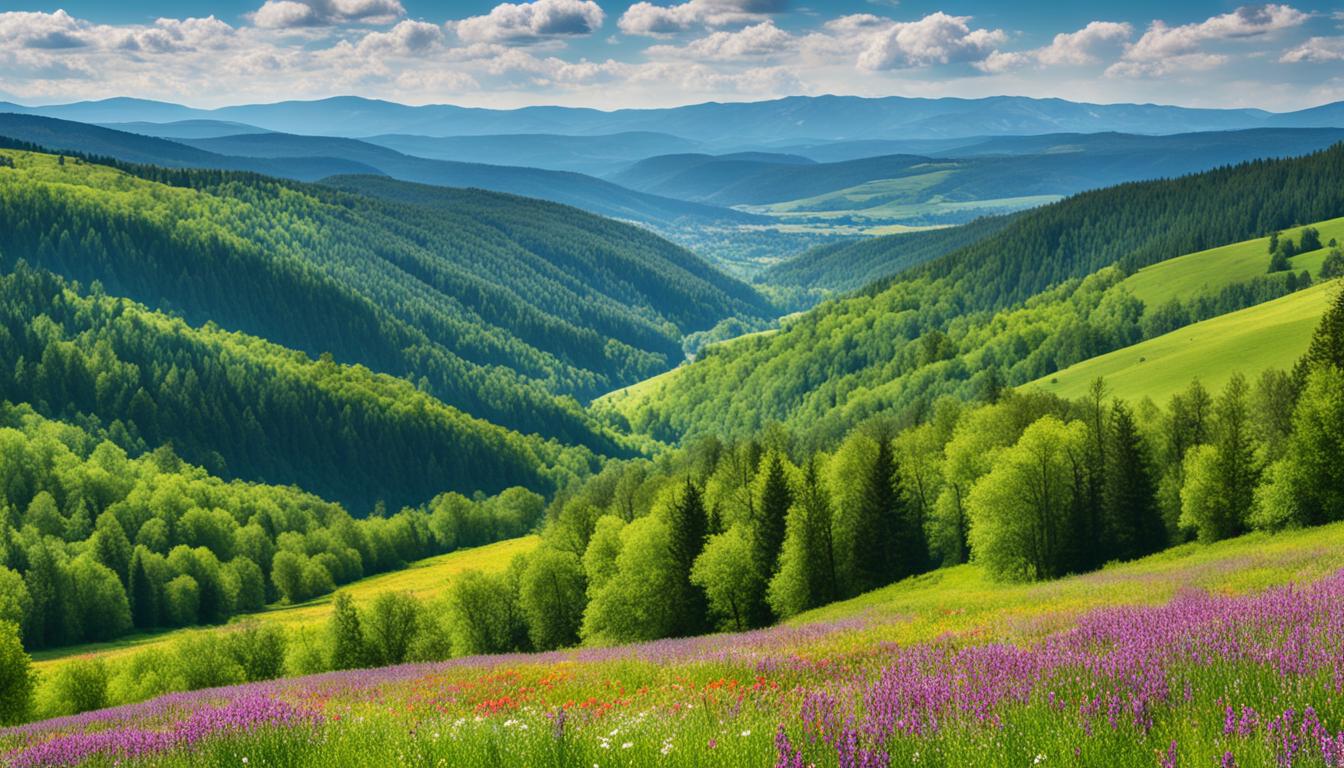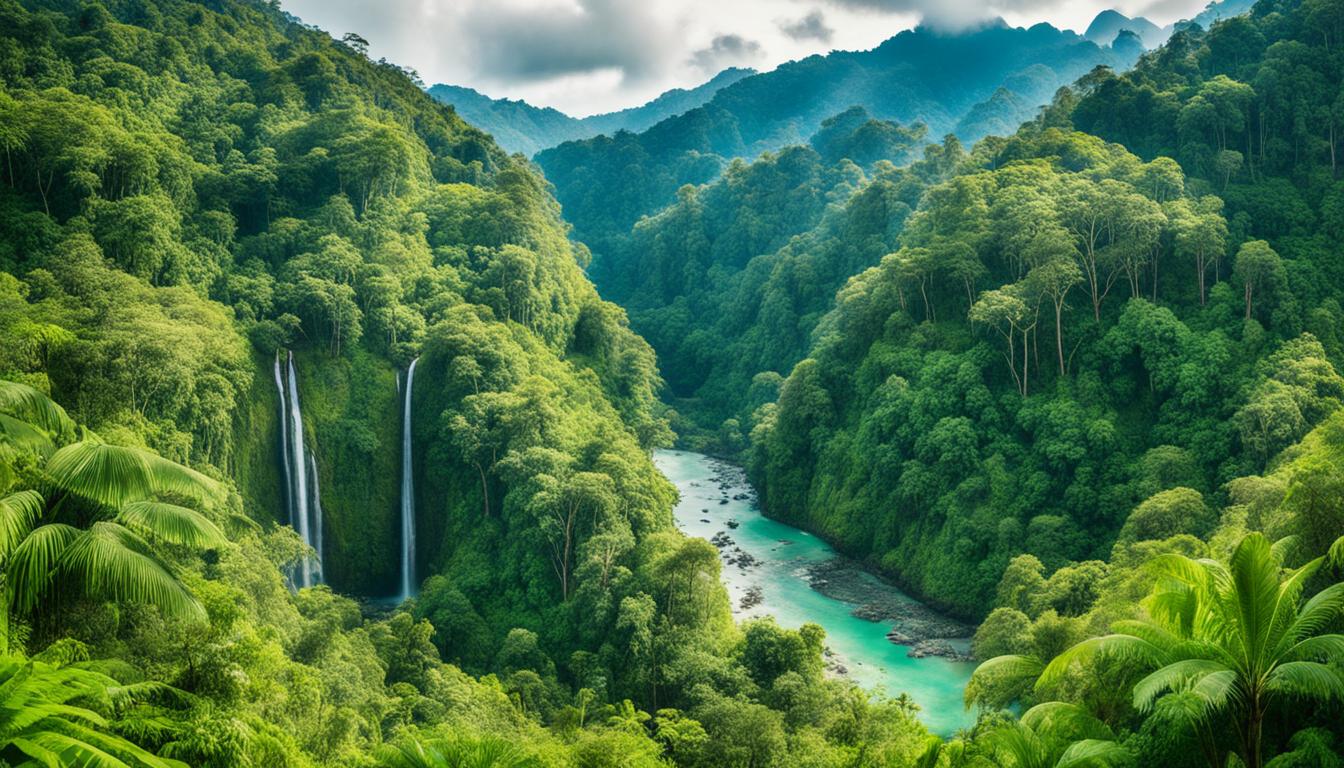Cambodia Sacred Natural Sites and Biodiversity
Did you know that Cambodia is home to a staggering number of sacred natural sites that are vital for preserving its remarkable biodiversity? These sites, which are considered sacred by local communities, not only hold cultural significance but also provide a habitat for endangered species and rare flora and fauna.
- Cambodia boasts numerous sacred natural sites that are integral to the nation’s biodiversity conservation efforts.
- These sites face threats from deforestation and land appropriation for economic purposes.
- Grassroots initiatives and collaborations are crucial for protecting these sites and raising awareness about their importance.
- The interplay between spirituality, culture, and conservation plays a significant role in the preservation of sacred natural sites.
- Understanding the cultural and philosophical underpinnings of these sites can strengthen conservation practices throughout Asia.
Virachey National Park: A Sanctuary for Biodiversity
Located in the provinces of Stung Treng and Ratanakiri, Virachey National Park is Cambodia’s largest protected area. This expansive park is renowned for its breathtaking natural beauty and diverse ecosystems, making it a true sanctuary for biodiversity. From upland savannah to lush lowlands and dense montane forests, Virachey National Park offers a wide range of habitats that support a rich variety of plant and animal species.
Within the park’s buffer zone, you’ll find several highlander tribes, including the Brao, Kreung, and Kavet communities. These indigenous groups have inhabited the area for generations and have a deep cultural connection to the land. Virachey National Park provides them with not only a physical home but also a spiritual sanctuary that is integral to their way of life.
With a legal allowance to engage in certain activities like fishing and hunting non-threatened species, the Brao, Kreung, and Kavet tribes maintain a sustainable and harmonious relationship with the park’s resources. Their traditional knowledge and practices ensure the preservation of the park’s natural balance.
Virachey National Park is teeming with a diverse array of wildlife, including some truly remarkable endangered species. Roaming freely within the park’s boundaries are magnificent Asian Elephants, elusive Clouded Leopards, and the mighty Gaur. These endangered species find solace within the park’s protected borders, making it a stronghold for their conservation.
The incredible biodiversity and cultural significance of Virachey National Park make it a place of immense value and importance. This natural sanctuary stands as a testament to Cambodia’s commitment to preserving its rich heritage and unique ecosystems. It is a destination that offers endless opportunities for exploration, adventure, and the chance to witness nature’s wonders firsthand.
Threats to Sacred Natural Sites in Cambodia
Sacred natural sites in Cambodia face several challenges that jeopardize their integrity and the biodiversity they safeguard. The rapid pace of deforestation, driven by the demand for agricultural land, poses a significant threat to these sites. Land appropriation for rubber and cashew plantations further exacerbates the problem, leading to habitat destruction and fragmentation. This destruction disrupts the delicate balance of ecosystems, putting numerous species at risk of extinction.
In addition to deforestation and land appropriation, hydropower development is another major concern. As Cambodia seeks to meet its growing energy needs, it has embarked on large-scale hydropower projects. Unfortunately, these developments often occur in the vicinity of sacred natural sites, causing disruption to rivers and water sources. The resulting contamination and altered flow patterns undermine the biodiversity of these fragile ecosystems.
The encroachment of modern lifestyles also poses a threat to the conservation of sacred natural sites. With the erosion of traditional animist heritage, the sites lose the protective cultural practices that have preserved them for generations. This gradual loss of knowledge and connection to the land further undermines conservation efforts and leaves the sites vulnerable to exploitation.
“The destruction of these sacred natural sites is not just an environmental tragedy but also a cultural loss. We must take urgent action to protect these invaluable treasures before it’s too late.” – A local environmental activist.
To address these threats, it is imperative that sustainable land-use practices are adopted, protecting the sacred natural sites from further degradation. This includes promoting alternative livelihood options for local communities, ensuring their economic well-being without compromising the conservation goals. Additionally, comprehensive environmental impact assessments should be conducted to evaluate the potential harm caused by hydropower development and devise strategies to mitigate its adverse effects.
The preservation of sacred natural sites requires a multi-faceted approach that recognizes the interdependence of cultural, environmental, and economic factors. By restoring and nurturing the traditional animist heritage, engaging local communities in conservation efforts, and fostering collaboration between different stakeholders, it is possible to ensure the long-term survival of these invaluable sites and the diverse species they harbor.
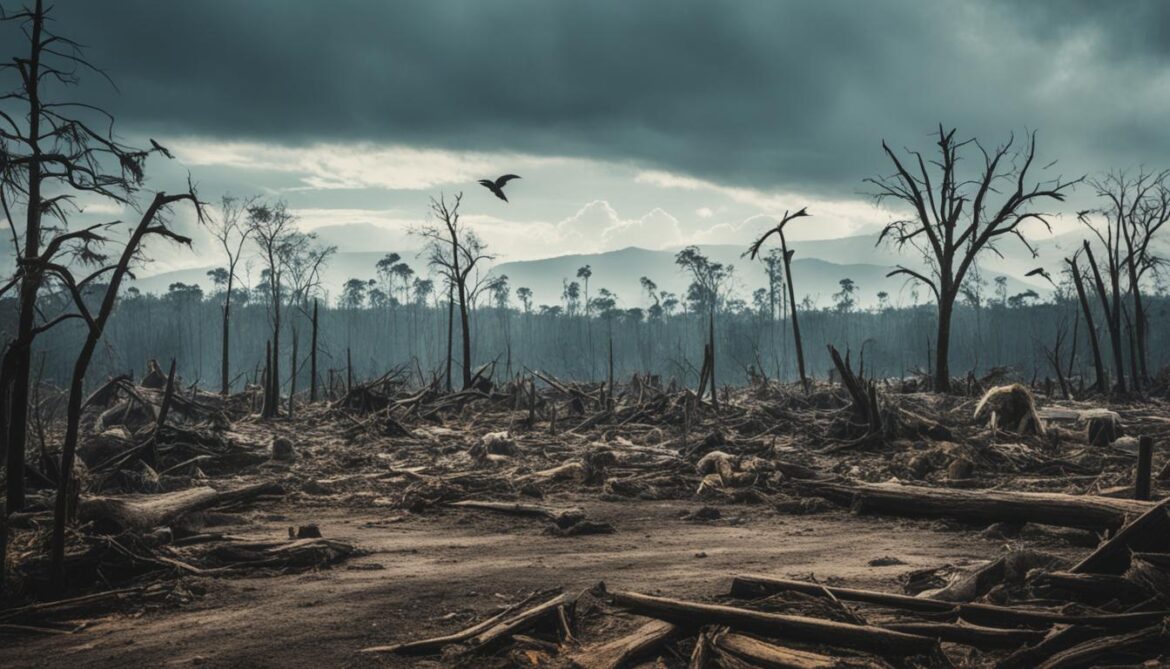
| Threats to Sacred Natural Sites in Cambodia | Impact |
|---|---|
| Deforestation | Loss of habitat, fragmentation of ecosystems, endangerment of species |
| Land appropriation | Habitat destruction, disruption of ecosystems, loss of cultural heritage |
| Hydropower development | Contamination, altered flow patterns, reduced biodiversity |
The Role of Sacred Natural Sites in Cambodian Culture
Sacred natural sites hold immense cultural significance for the local communities in Cambodia, especially for the Brao people. These sites are believed to be the dwelling places of powerful deities and spirits, who are revered for their ability to bring rain, heal the sick, and even release prisoners. The Brao people deeply respect these spirit mountains and faithfully adhere to the rules and restrictions associated with them, recognizing the importance of maintaining the harmony between humans and nature.
The animist heritage of the Brao people is woven intricately with the mythology and folklore surrounding these sacred sites. In each village and tribe, there are unique narratives and traditions that celebrate the sacredness of the natural environment. These animist folklore tales are passed down through generations, serving as a means of preserving and imparting cultural wisdom.
“These sacred natural sites are the essence of our animist heritage. They connect us to our ancestors and remind us of our responsibility to protect and preserve the gifts of nature,” says Samnang, a Brao elder.
The stories and beliefs associated with these sites affirm the Brao people’s reverence for nature and their commitment to sustainable coexistence with the environment. The animist folklore and rituals serve as a testament to the deep-rooted connections between culture, spirituality, and the natural world.
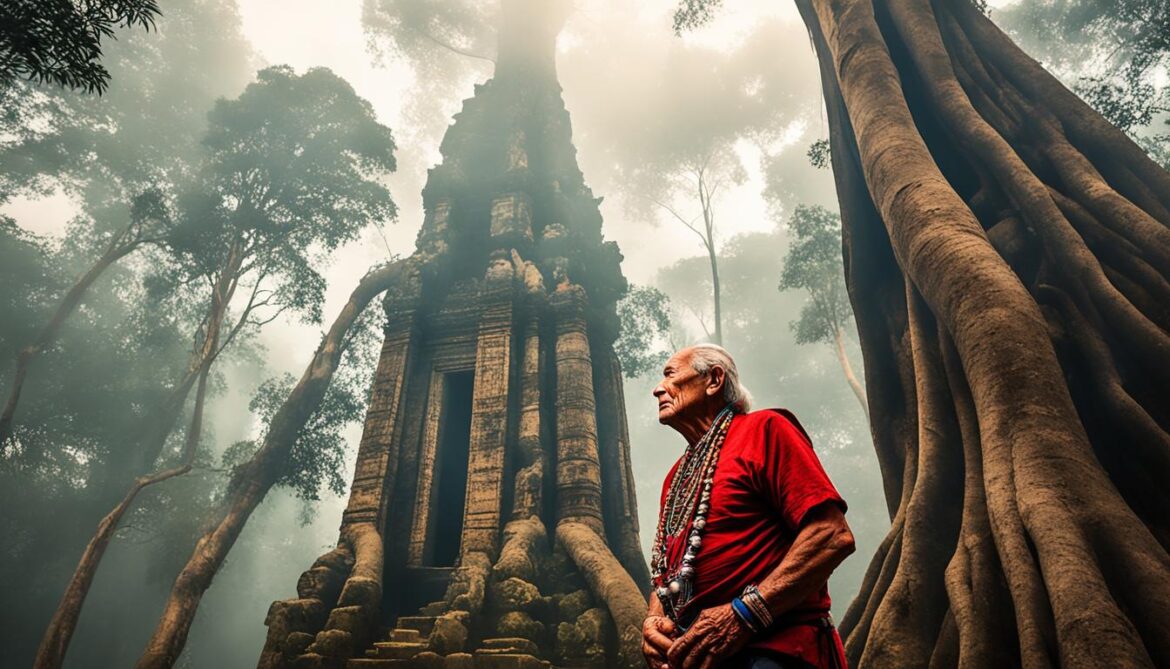
The Brao People: Guardians of Sacred Natural Sites
The Brao people have a crucial role as the custodians and guardians of the sacred natural sites in Cambodia. They consider it their responsibility to ensure the well-being and protection of these sites, as they are integral to their cultural identity and heritage.
For the Brao people, the sacred natural sites are not just physical places but also embodiments of ancestral wisdom, spiritual power, and natural balance. They work together to maintain the sacredness of these sites and follow traditional practices that honor the spirits and maintain the ecological harmony.
The Spiritual Significance of Animist Heritage
The animist heritage of the Brao people is deeply intertwined with their spirituality. Through their animist beliefs and rituals, they acknowledge the interdependence of humans and the natural world, recognizing that their well-being is connected to the health of the environment.
“Our animist heritage guides us to live in unity with nature. We believe that by protecting the sacred natural sites, we ensure our own prosperity and the continuation of our cultural legacy,” explains Sopheap, a Brao community leader.
By upholding their animist heritage and respecting the sacred natural sites, the Brao people strive to maintain the balance and harmony needed for their communities to flourish and thrive.
Preserving Animist Heritage for Future Generations
As Cambodia undergoes rapid modernization and cultural changes, there is a growing need to preserve and promote the animist heritage of the Brao people. Recognizing the importance of cultural continuity, efforts are being made to document and share the animist folklore and rituals associated with the sacred natural sites.
Storytelling sessions and cultural exchanges are organized to educate younger generations about the significance of these sites and foster a sense of pride and responsibility towards their preservation. These initiatives not only contribute to the conservation of the animist heritage but also strengthen the cultural fabric of the Brao communities.
| Key Elements of Brao Animist Heritage | Cultural Significance |
|---|---|
| Storytelling and Myths | Passing down cultural wisdom and knowledge |
| Rituals and Ceremonies | Honoring spirits and maintaining ecological balance |
| Taboos and Restrictions | Preserving the sanctity and integrity of the sacred sites |
| Community Participation | Fostering a sense of belonging and collective responsibility |
The preservation of animist heritage is crucial for the continuity of the cultural practices and values associated with the sacred natural sites. By safeguarding this rich heritage, the Brao people ensure the sustainable management and protection of these sites for future generations.
Conservation Efforts in Cambodia
Conservation efforts in Cambodia are driven by grassroots initiatives that are committed to protecting the sacred natural sites and preserving biodiversity. These initiatives play a vital role in safeguarding the nation’s unique natural heritage through their tireless commitment and determination.
One notable conservation project in Cambodia is the camera-trapping project in Virachey National Park. This project aims to verify the presence of critically endangered species within the park and actively involves indigenous people, park rangers, NGO workers, and tour operators. Through collaboration and data collection, the camera-trapping project provides crucial information on the park’s biodiversity and guides conservation strategies to protect these species from extinction.
Alongside the camera-trapping project, storytelling sessions are organized to raise awareness among tourists and young locals about the significance of the sacred natural sites and their associated legends. These sessions serve as educational platforms, highlighting the intrinsic value of these sites and promoting their conservation. By fostering a sense of connection and knowledge, storytelling sessions empower individuals to take action and protect these invaluable spaces.
“Conservation efforts in Cambodia rely on the dedication and collaboration of local communities, organizations, and institutions. By working together, we can ensure the long-term survival of Cambodia’s sacred natural sites and preserve our rich biodiversity for future generations.”
In addition to the camera-trapping project and storytelling sessions, treks to sacred mountains are organized to provide immersive experiences, allowing visitors to witness the beauty and importance of these sites firsthand. These treks offer a unique opportunity to explore the natural wonders of Cambodia while deepening one’s understanding of the cultural and ecological significance of these sacred spaces.
Through grassroots efforts, such as the camera-trapping project, storytelling sessions, and treks to sacred mountains, Cambodia’s conservation initiatives are making a significant impact. These efforts not only contribute to the preservation of sacred natural sites but also raise global awareness about the value of Cambodia’s unique natural heritage. By engaging individuals and communities in conservation practices, Cambodia is paving the way for a sustainable future that prioritizes the protection of its sacred natural spaces.
| Conservation Efforts | Aims | Participants |
|---|---|---|
| Camera-Trapping Project | Verify presence of critically endangered species | Indigenous people, park rangers, NGO workers, tour operators |
| Storytelling Sessions | Raise awareness about the significance of sacred natural sites | Tourists, young locals |
| Treks to Sacred Mountains | Provide immersive experiences and deepen understanding | Visitors |
Policy and Legal Framework for Sacred Natural Sites
Indigenous rights, protective laws, and a temporary moratorium are key components of the policy and legal framework for sacred natural sites in Cambodia.
Indigenous communities in Cambodia have the legal right to engage in certain activities within these sites, such as fishing, collecting non-timber forest products, and hunting non-threatened species. These rights recognize the cultural and traditional significance of these sites to indigenous peoples and aim to protect their way of life.
However, despite these protective laws, the rights of indigenous communities within sacred natural sites are often threatened by external forces. High-paying markets for rare species, like the Pangolin, drive illegal poaching and trafficking, undermining conservation efforts and jeopardizing the delicate balance of these ecosystems.
“The protection of sacred natural sites is vital for the preservation of biodiversity and indigenous cultures. Our laws play a crucial role in safeguarding the rights of these communities and conserving these unique ecosystems,” says Dr. Sophea Thong, a leading expert on environmental law in Cambodia.
The World Bank initially supported the protection of sacred natural sites in Cambodia, recognizing their importance for biodiversity conservation and indigenous rights. However, this support was terminated when the Cambodian government allowed exploration of valuable minerals within the sites. The subsequent logging, poaching, and encroachment threatened the integrity of these sites and the indigenous communities who depend on them.
In response to these threats, a temporary moratorium was implemented to address the challenges facing sacred natural sites. This moratorium aims to restrict commercial activities and provide the necessary time and space for communities, researchers, and policymakers to develop sustainable solutions that protect both cultural heritage and biodiversity.
The temporary moratorium serves as a critical intervention, enabling stakeholders to reassess the value of these sites, address the external pressures they face, and explore alternative approaches for their conservation.
Advocacy for Indigenous Rights and Conservation
Efforts are underway to advocate for the rights of indigenous communities and establish stronger legal protections for sacred natural sites in Cambodia. The Indigenous Rights Network, in collaboration with environmental organizations, is actively engaged in promoting awareness and lobbying for comprehensive legislation to safeguard these sites.
Through their collective advocacy, indigenous communities and environmentalists aim to secure long-term protective measures that recognize the interconnectedness of indigenous rights, environmental sustainability, and the preservation of sacred natural sites.
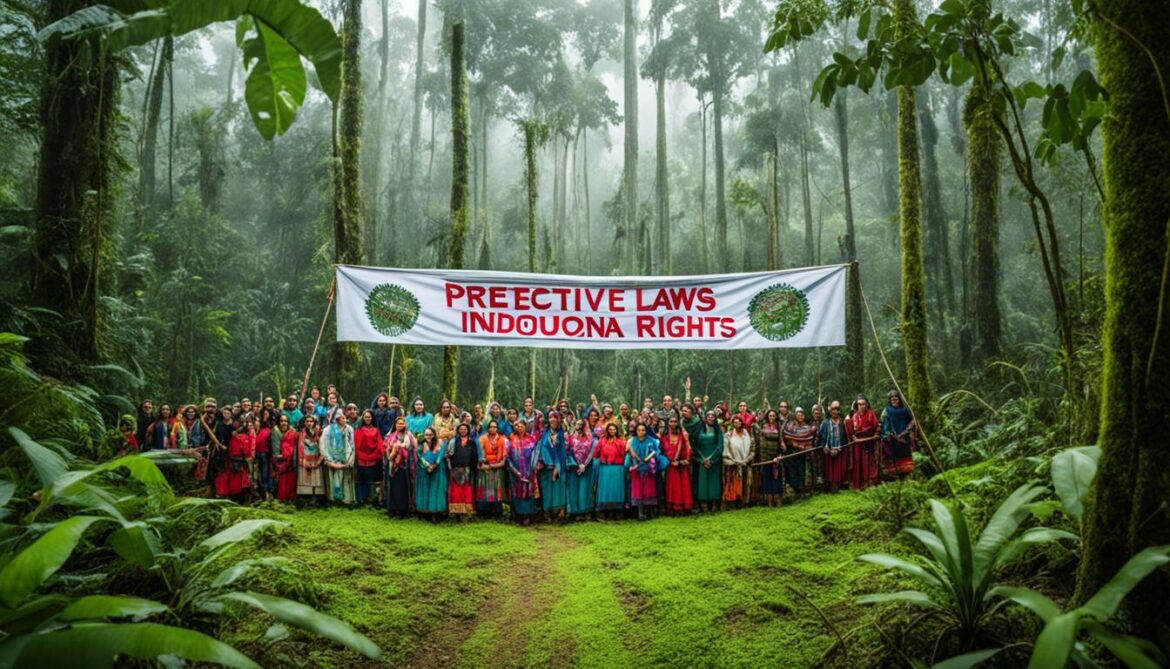
The Way Forward
The future of sacred natural sites in Cambodia hinges on a comprehensive legal framework that upholds and protects the rights of indigenous communities while ensuring the long-term conservation of these ecosystems.
Collaboration among indigenous communities, civil society organizations, government agencies, and international partners is essential to develop and implement effective policies that balance economic development with the preservation of sacred natural sites. It is only through open dialogue, mutual respect, and shared decision-making that sustainable solutions can be achieved.
By prioritizing the rights of indigenous communities and enacting protective laws, Cambodia can continue to be a global leader in the conservation of sacred natural sites, setting an example for other countries facing similar challenges.
| Key Points | Importance |
|---|---|
| Indigenous rights | Recognizing the rights and cultural significance of indigenous communities |
| Protective laws | Legal measures to safeguard sacred natural sites and their biodiversity |
| Temporary moratorium | Addressing threats to sacred natural sites and allowing time for sustainable solutions |
| Advocacy for indigenous rights | Promoting awareness and lobbying for stronger legal protections |
| Collaboration | Working together to develop and implement comprehensive policies |
Collaboration and Future Prospects
Collaboration plays a crucial role in the conservation of sacred natural sites in Cambodia. However, at present, collaboration among different stakeholders is poor, hindering efforts to protect these significant sites. Compounding this issue is the existence of a corrupt government, further complicating conservation initiatives. The social fabric within villages is beginning to fray as land is sold to outsiders, posing a threat to the preservation of these sacred spaces.
Despite these challenges, there is hope for the future. Organizations like Habitat ID, a non-governmental organization, are actively involved in raising awareness about the value of sacred natural sites and advocating for their protection. Additionally, several universities in the region are participating in research and educational initiatives, contributing to the collective efforts to conserve these sites.
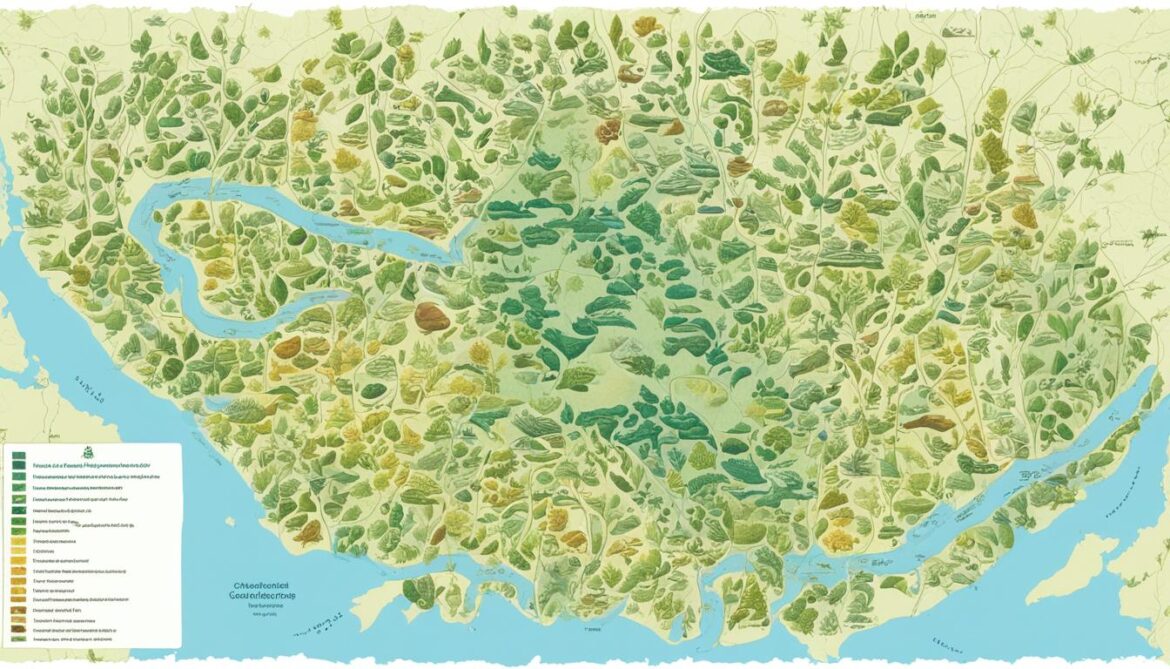
The involvement of these organizations and academic institutions is a positive development and indicates the potential for collaboration and future conservation efforts. By working together and fostering partnerships between local communities, NGOs, and the government, it is possible to address the current challenges and establish effective strategies for the protection and preservation of Cambodia’s sacred natural sites.
Conservation Tools for Sacred Natural Sites
Conservation of sacred natural sites in Cambodia relies on a range of tools and approaches that aim to preserve the cultural and natural significance of these locations. Traditional nature-friendly practices are reinforced, while awareness is raised among both local communities and outsiders.
Animistic ecotourism serves as a central concept in the protection of sacred natural sites. Through storytelling sessions and trekking tours, visitors are educated about the unique cultural and natural values associated with these sites. This approach fosters a deeper appreciation for the interconnectedness of spirituality, culture, and environmental conservation.
By immersing themselves in the enchanting tales and history of these sites, visitors gain a greater understanding of the symbiotic relationship between humans and the natural world.
Research and documentation play an essential role in conveying the value and importance of sacred natural sites to policymakers and the wider public. Detailed studies of traditional practices, traditions, and natural features associated with these sites contribute to a deeper understanding of their significance.
Motion-triggered camera-trapping is another crucial tool used in the conservation of sacred natural sites. By capturing images and footage of the wildlife inhabiting these areas, camera-trapping helps verify claims about the presence of rare and locally extinct species within these sites. This scientific evidence bolsters the case for their protection and highlights the unique biodiversity they support.
Example of Camera-Trapping Results at a Sacred Natural Site:
| Species | Number Detected |
|---|---|
| Red-shanked Douc Langur | 15 |
| Crested Serpent Eagle | 8 |
| Indochinese Tiger | 3 |
Camera-trapping not only provides invaluable insights into the biodiversity of these sites but also serves as a means to engage and educate local communities and visitors about the importance of wildlife conservation.
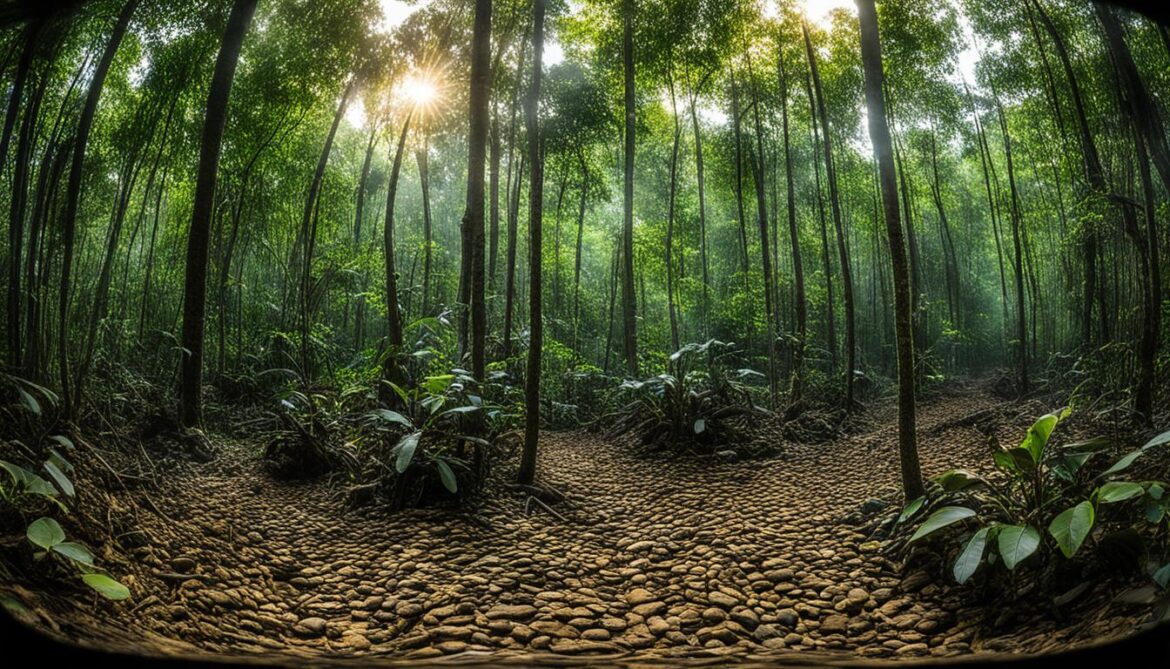
The use of animistic ecotourism, research and documentation, as well as camera-trapping, ensures that sacred natural sites in Cambodia are protected and celebrated for their unique natural and cultural values. The combined efforts of these conservation tools contribute to the preservation of these irreplaceable sites and promote a harmonious coexistence between humans and the natural world.
Results and Advocacy
The conservation efforts in Cambodia have produced promising results, evident through a plethora of academic publications focused on the region’s biodiversity and the cultural significance of its sacred natural sites. Researchers, environmentalists, and local communities have collaborated extensively to gather valuable knowledge about these sites and their conservation needs.
An expansive network of informants and translators has been established, facilitating meaningful interactions with local communities. These individuals have ventured into numerous villages in the buffer zone of Virachey National Park, diligently documenting the traditions, legends, and customs associated with the sacred natural sites. Their immersive engagement with the communities has enabled them to serve as dedicated advocates for the rights and conservation of these culturally significant spaces.
As advocates, they actively contribute to processes such as nominating and managing World Heritage Sites. Their deep understanding of the region’s cultural heritage and natural values empowers them to effectively communicate the importance of preserving these sites for future generations.
Efforts are also underway to compile a book dedicated to the myths and legends of the spirits inhabiting the region. This book will serve as a valuable resource, distributed among the villages to further raise awareness about the spiritual and cultural significance of the sacred natural sites. By sharing these stories and legends, the aim is to inspire a sense of pride and responsibility among local communities, encouraging their active participation in the preservation of these culturally and ecologically vital spaces.
Ultimately, the combination of academic publications, an expansive network of informants, and the distribution of myths and legends aims to foster a deep appreciation and understanding of the interconnection between nature, culture, and conservation. These initiatives play a vital role in creating a sustainable future for Cambodia’s sacred natural sites and reinforcing the importance of preserving the unique biocultural heritage present within them.

Advocacy through Research: Key Findings
| Key Findings | Implications |
|---|---|
| Academic publications on Cambodia’s sacred natural sites | Showcase the cultural and ecological significance of these sites, promoting conservation awareness on a global scale |
| Expansive network of informants and translators | Facilitate meaningful engagement with local communities, serving as advocates for the preservation of sacred natural sites |
| Publication of a book containing myths and legends | Foster local pride and responsibility, emphasizing the importance of cultural heritage and nature conservation |
The Power of Spirituality in Conservation
The interrelationship between spirituality and conservation is a central theme in the preservation of sacred natural sites in Cambodia. These sites, believed to embody both physical and spiritual aspects, hold immense cultural and environmental significance. The traditional belief systems and practices rooted in spirituality and religion are powerful agents for environmental conservation, contributing to the protection of both the biocultural diversity and the physical environment.
“The preservation of sacred natural sites aligns with our cultural and environmental values. It represents the interplay between our spirituality and our responsibility to safeguard the natural world,”
says Sreyka, a local community leader.
Recognizing this interrelationship unlocks a deeper understanding of the interconnectedness between humans, the environment, and spirituality. By harnessing the power of spirituality, conservation practices can become more effective and sustainable, ensuring the preservation of both cultural heritage and biological diversity.
Preserving Biocultural Diversity
The concept of biocultural diversity emphasizes the intrinsic link between biological diversity and cultural diversity. Sacred natural sites embody this interplay by being spaces where cultural heritage and biodiversity converge. The spiritual beliefs and practices associated with these sites encourage the protection and sustainable use of natural resources, contributing to the preservation of biocultural diversity.
- Spirituality and Environment: The spiritual connection to the environment nurtures a deep sense of reverence and respect for nature. It compels individuals and communities to live in harmony with the natural world, fostering practices that prioritize conservation and sustainable resource management.
- Safeguarding Tradition: Sacred natural sites are deeply rooted in local traditions and provide a link to ancestral knowledge and wisdom. They serve as spaces for cultural practices, ceremonies, and rituals, ensuring the transmission of cultural heritage from one generation to the next.
- Community Stewardship: Spiritual beliefs often foster a sense of communal responsibility for the environment. Local communities act as stewards of the land, collectively managing and protecting sacred natural sites through customary practices and traditional governance systems.
Environmental Conservation through Spirituality
Spirituality plays a transformative role in environmental conservation by nurturing a sense of interconnectedness and stewardship. The spiritual connection to nature encourages individuals and communities to adopt sustainable practices and advocate for the preservation of natural resources.
“Our spiritual beliefs guide us to treat the environment with reverence and care. We understand that everything is interconnected, and by protecting nature, we are also protecting ourselves,”
explains Sovann, a local spiritual leader.
The power of spirituality is harnessed through various conservation initiatives in Cambodia:
- Educational Programs: Spiritual leaders and elders conduct educational programs to raise awareness among community members and visitors about the importance of sacred natural sites and their role in biodiversity conservation.
- Sustainable Resource Management: Spiritual beliefs guide communities in practicing sustainable resource management, such as rotational farming, selective hunting, and responsible harvesting of non-timber forest products.
- Cultural Tourism: Spiritual leaders and community members lead cultural tourism initiatives that highlight the spiritual significance of sacred natural sites. These initiatives generate income for the community while promoting the values of conservation and respect for the environment.
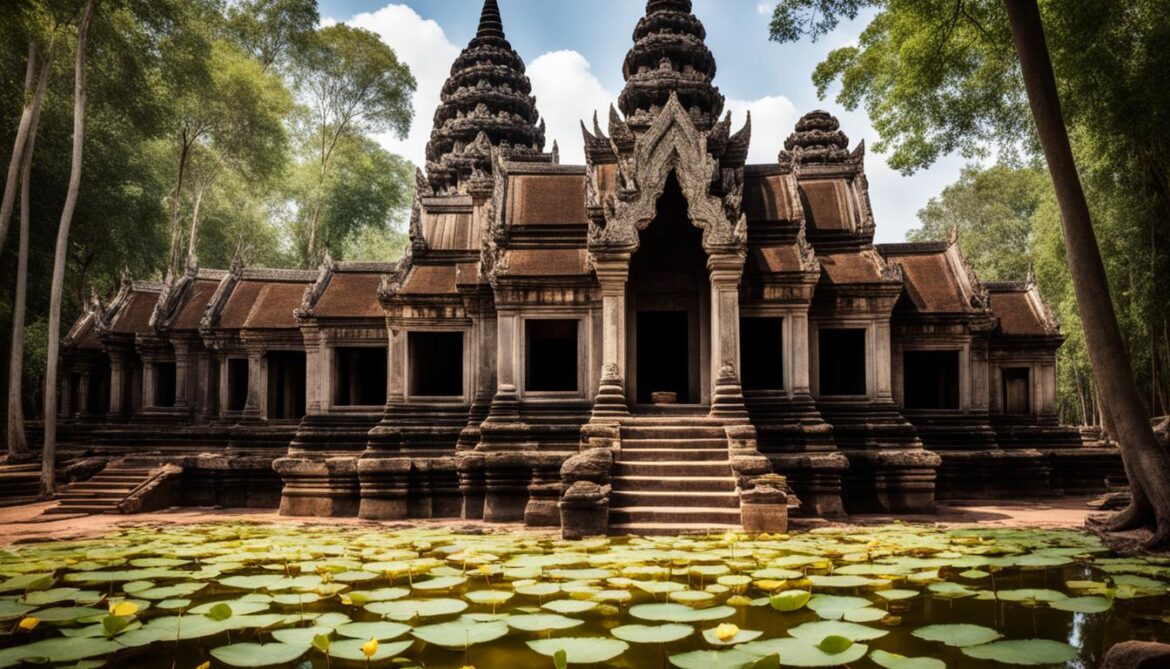
Spirituality has the power to inspire transformative change and influence conservation efforts. By recognizing the interrelationship between spirituality, the environment, and biocultural diversity, Cambodia can build a sustainable future that preserves its natural and cultural heritage for generations to come.
The Importance of Sacred Natural Sites in Asian Context
The significance of Asian sacred natural sites extends beyond Cambodia, as traditional societies throughout Asia assign special status to these sites. These sites not only serve as vital hubs for cultural integrity but also provide a framework for effective conservation practices. This publication focuses on sacred natural sites within the Asian region, delving into case studies from various countries and exploring the associated philosophies and practices.
By understanding the cultural, spiritual, and philosophical underpinnings of sacred natural sites, conservation efforts in Asia can be significantly strengthened, creating a more sustainable approach to preserving natural and cultural heritage. These sites serve as a testament to the interconnectedness between humans and nature, highlighting the importance of recognizing and respecting the cultural and spiritual dimensions of environmental conservation.
Case Studies across Asia
It is essential to examine a range of case studies across Asia to gain a comprehensive understanding of the role and impact of sacred natural sites in the region. These case studies provide valuable insight into the practices and beliefs associated with these sites.
One example is the Arashiyama Bamboo Forest in Kyoto, Japan. This sacred natural site is not only a beautiful tourist attraction but also holds immense cultural significance for the local community. The forest is considered a place of meditation and spiritual retreat, attracting visitors seeking tranquility and connection with nature.
Other notable case studies include the Mount Kailash in Tibet, the Batu Caves in Malaysia, and the Ta Prohm temple in Cambodia. Each of these sites showcases diverse cultural traditions, religious practices, and ecological conservation efforts.
Conservation Principles and Practices
In order to ensure the effective conservation of sacred natural sites throughout Asia, a set of principles and practices should be followed. These principles should respect and integrate the cultural beliefs and values associated with these sites.
- Community Engagement: Involving local communities in the decision-making process and empowering them to take an active role in conservation efforts.
- Education and Awareness: Creating awareness about the significance of these sites and fostering a sense of responsibility among local communities and visitors.
- Collaboration and Partnerships: Forging partnerships with relevant stakeholders, including governments, NGOs, and local organizations, to mobilize resources and promote sustainable practices.
- Research and Monitoring: Conducting scientific research and monitoring the ecological health of these sacred natural sites to inform conservation strategies.
- Sustainable Tourism: Developing responsible tourism strategies that minimize negative impacts on the environment and culture while providing economic benefits to the local communities.
Conclusion
The sacred natural sites of Cambodia play a crucial role in the conservation of biodiversity and the preservation of cultural heritage. These sites provide vital habitats for rare flora and fauna, fostering a delicate balance between nature and local communities. However, they face significant threats posed by deforestation and land appropriation.
Protecting these sacred natural sites requires the collective effort of grassroots initiatives and collaboration among stakeholders. By raising awareness about their significance and involving local communities, we can safeguard these precious sites for future generations. Recognizing the interplay between spirituality, culture, and conservation is key to achieving a sustainable future that values both the natural and cultural diversity of Cambodia – and indeed, Asia as a whole.
Let us continue to support the conservation efforts in Cambodia and ensure the preservation of these sacred natural sites. By doing so, we take a step towards safeguarding our biodiversity and honoring the rich cultural heritage that these sites represent.
FAQ
What are sacred natural sites in Cambodia?
What is Virachey National Park?
What are the threats to sacred natural sites in Cambodia?
How are sacred natural sites significant in Cambodian culture?
What are the conservation efforts in Cambodia?
What is the policy and legal framework for sacred natural sites in Cambodia?
How is collaboration and future prospects for conservation in Cambodia?
What are the conservation tools for sacred natural sites in Cambodia?
What are the results and advocacy for conservation in Cambodia?
How does spirituality play a role in the conservation of sacred natural sites?
What is the importance of sacred natural sites in the Asian context?
Is there a conclusion to these discussions?
Source Links
- https://bioone.org/journals/mountain-research-and-development/volume-37/issue-2/mrd.mm205/Asian-Sacred-Natural-Sites–Philosophy-and-Practice-in-Protected/10.1659/mrd.mm205.full
- https://sacrednaturalsites.org/items/preserving-nature-and-culture-with-animistic-ecotourism-in-cambodia/
- https://www.visitsoutheastasia.travel/guides/natural-wonders-of-cambodia/




